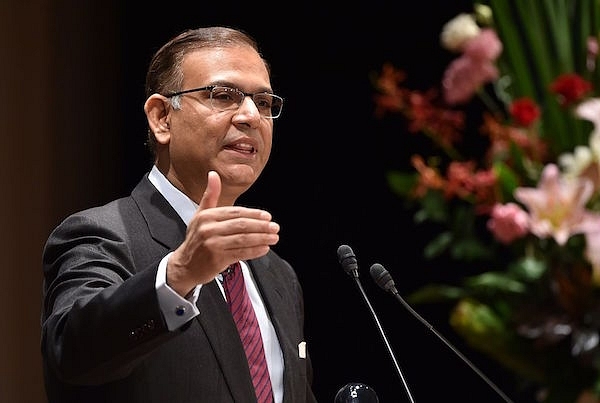Politics
What The Civil Aviation Sector Needs From Jayant Sinha
- Many hope that Jayant Sinha’s move to the Ministry of Civil Aviation will ensure that a dynamic minister is in place to implement the National Civil Aviation Policy. But sadly, the policy isn’t all that good, to begin with.
- Here are three possible ways to ensure civil aviation in India grows to its full potential.

Image Credit: KAZUHIRO NOGI/AFP/Getty Images
Recently, when PM Modi reshuffled his cabinet, Jayant Sinha was moved from his role as Minister of State (MoS) for Finance, where he worked under Arun Jaitley, to MoS for Civil Aviation, where he will be working under Ashok Gajapati Raju of the Telugu Desam Party. The reasons for this shift are unclear and will, in all probability, remain that way.
Many hope that Jayant Sinha’s move to the Ministry of Civil Aviation (MoCA) will ensure that a dynamic minister is in place to implement the National Civil Aviation Policy (NCAP), which was approved by the cabinet a month ago. But sadly, the policy isn’t all that good, to begin with.
Jayant Sinha’s predecessor was a populist who appeared to be the strongest advocate in the ministry of partly retaining the 5/20 rule as well as the recently introduced Regional Connectivity Scheme (RCS) aimed at the cross-subsidisation of regional routes by the normal routes. So the best that one can hope from this change in personnel are the following:
1. Remove the remnants of the 5/20 policy
As many industry experts have pointed out, the replacement of the 5/20 policy, which required Indian airlines to have flown for a minimum of five years and operate at least 20 aircraft to be allowed to fly on international routes, with the 0/20 policy is, in effect, a 3/20 rule. It would take a new airline a minimum of 2.5 to 3 years to ramp up its fleet size to above 20. The rule will, therefore, continue to remain a constraint on the growth of the aviation sector, albeit in a different form.
To make it easier for the new minister, he can make a case against the change with an argument such as this:
‘0/20 rule is a constraint to India’s Look East policy, as it will disallow new northeastern airlines with more knowledge of local conditions from flying on routes between cities in the North East and nearby cities in Southeast Asia.’
2. Scrap the Regional Connectivity Scheme
The Regional Connectivity Scheme announced in the National Civil Aviation Policy was, as per a report, opposed by the Government of India policy think-tank, Niti Aayog, as the cross-subsidy was costly and tampered with the way the market worked. The report also said that the scheme ended up in the civil aviation policy only because MoCA Secretary Rajiv Choubey gave repeated presentations on the same to the Prime Minister’s Office.
The new MoS will soon realise that the scheme is market-distortive, and will turn out to be very costly. The proposed cess will only have to increase in time with more states signing up for the scheme.
The supporters of the scheme will say that regional connectivity is important for the economic growth of unconnected areas (admirable intentions as always). But they would do well to remember that the 5/20 policy had supporters who gave ‘admirable reasons’ too, like increasing the number of aircraft flying on domestic routes. Those admirable reasons do not negate the fact that 5/20 was anti-growth. If the RCS is not scrapped early, it will prove very difficult to remove it (just like the 5/20).
3. Resolve confusion on the FDI norms for the sector
The recent relaxation of the FDI norms, which allowed for up to 100 percent FDI in the aviation sector under the government approval route, was initially cheered by most players in the aviation sector. However, doubts have started to creep in, as Substantial Ownership and Effective Control (SOEC) norms effectively require Indian management and control to remain.
The contradictory nature of all this seems to have escaped those in the government. The new MoS should clarify the same along with the Department of Industrial Policy & Promotion, as this ambiguity is quite unnecessary, especially so at a time when the sector is headed towards a much greater expansion.
The sad part about Jayant Sinha’s move from the Finance Ministry to the MoCA is that he came in after the National Civil Aviation Policy was drafted under Mahesh Sharma. If he were there earlier, the policy in all probability would have been a much better one.
Support Swarajya's 50 Ground Reports Project & Sponsor A Story
Every general election Swarajya does a 50 ground reports project.
Aimed only at serious readers and those who appreciate the nuances of political undercurrents, the project provides a sense of India's electoral landscape. As you know, these reports are produced after considerable investment of travel, time and effort on the ground.
This time too we've kicked off the project in style and have covered over 30 constituencies already. If you're someone who appreciates such work and have enjoyed our coverage please consider sponsoring a ground report for just Rs 2999 to Rs 19,999 - it goes a long way in helping us produce more quality reportage.
You can also back this project by becoming a subscriber for as little as Rs 999 - so do click on this links and choose a plan that suits you and back us.
Click below to contribute.
Latest